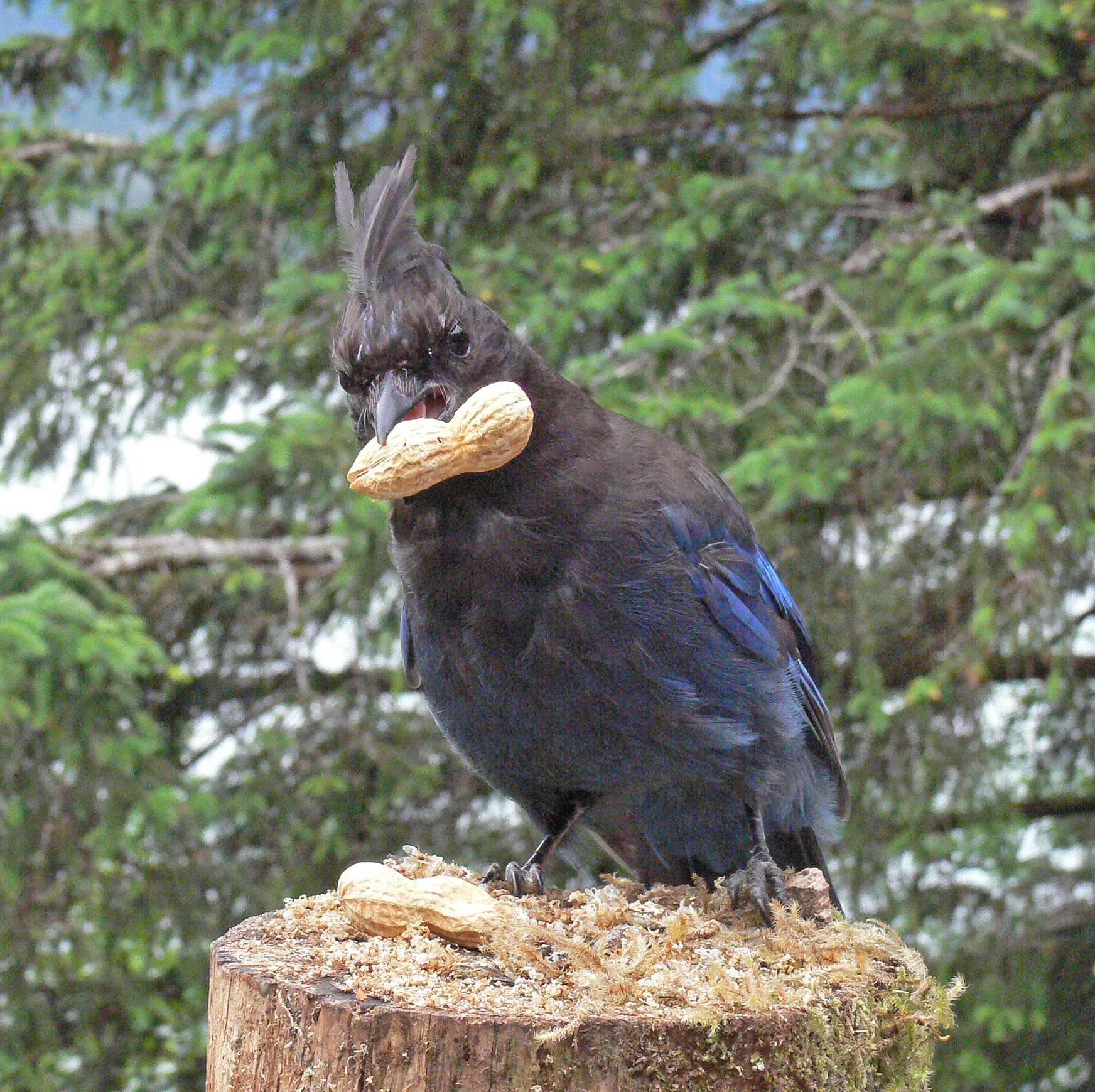On a recent hike, I heard a volley of high-pitched screams coming from a thick stand of small spruces just beside the trail. They sounded very much like the cries of a red-tailed hawk, but that bird would be highly improbable in such a place and at this time of year (February). Surely it was a Steller’s jay, which is well-known to mimic redtails and some other birds as well.
That small incident set off some musings about our Steller’s jay and jays in general. Steller’s jays are omnivorous, eating all sorts of things, including bird eggs and nestlings, carrion, insects, seeds and fruits. I was thinking in particular about their role in seed dispersal; when they eat fruits, the seeds pass through the digestive tract and get deposited, sometimes in a place where they can germinate and grow. The jays share this important ecological task of seed dispersal with thrushes, waxwings, crows and ravens, bears, coyotes, marten and other animals.
They are also seed predators, along with sparrows and finches, chickadees, squirrels, mice and others. In this capacity, they raid bird feeders and train humans to offer peanuts. Sometimes they cache their seedy prizes under a bit of moss or a stick. Peanuts and most seeds offered in seed feeders don’t grow well here, but cached sunflower seeds sometimes produce seedlings in improbable places.
I don’t know how often our jays consume the seeds of our trees (spruce, hemlock, pine, cottonwood, alder, willow); all of these seeds are small and typically dispersed by wind; they probably don’t offer much nutrition to a relatively large bird such as a jay. However, in more southerly portions of their geographic range, Steller’s jays are known to harvest and cache the seeds of several conifers. Not all of these caches are retrieved and the seeds germinate, so there the Steller’s jays are contributing (along with other kinds of jays and Clark’s nutcracker) to seed dispersal, a critical portion of a plant’s life cycle.
Steller’s jays are closely related to the blue jays that live in wooded areas of eastern North America. The blue jay is also an omnivore; among its varied dietary items are acorns and beechnuts. Blue jays harvest and cache these items, sometimes several kilometers from the mother trees. They are much better dispersal agents than squirrels, which cache nuts but don’t travel as widely. Researchers think that blue jays were important in the development of northern forests as the Pleistocene glaciers retreated by carrying nuts northward to ice-free zones and stashing them.
Neither of these jays is as specialized to a diet of seeds as the pinyon jay of the southwestern U. S. or the more distantly related Clark’s nutcracker of the mountain west. Both of these species depend on conifer seeds year-round, even feeding cached seeds to their chicks early in the summer. Both species travel long distances, sometimes many kilometers, to cache their harvested seeds and both have excellent spatial memories for retrieving those seeds. But, as usual, not all seeds are retrieved and because they are often cached in good sites for germination, they become important for forest regeneration. As our climate changes, they and other seed-caching birds could facilitate altitudinal shifts in tree distribution.
Without the seed-caching jays and their relatives, some forests cannot regenerate. For example, pinyon pines are dispersed by western scrub jays (along with nutcrackers and pinyon jays). A study in New Mexico, where scrub jays were the main pineseed dispersers, showed that near a very noisy industrial area, the jays became extremely rare and, correspondingly, there were many fewer pinyon pine seedlings in the forest, while at the same time, in a relatively quiet area, both jays and seedlings were common. Noise pollution drove out the jays and severely reduced pine forest regeneration.
There isn’t room here to sketch out the whole story of jays and nutcrackers, their adaptations for seed harvesting and caching, the adaptations of trees that facilitate seed dispersal by these birds, and the sometimes complex interactions with other seed-eaters, such as mice and squirrels. For the time being, suffice it to note that the interdependence of these birds and certain trees means that if one side of the mutualism fades away, the other side declines too.
• Mary F. Willson is a retired professor of ecology.

